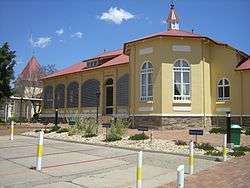Namibia University of Science and Technology
 Logo of Namibia University of Science and Technology | |
Motto in English | Technology and development |
|---|---|
| Established | 1994 |
| Chancellor | Peter Katjavivi |
| Vice-Chancellor | Tjama Tjivikua |
Academic staff | ≥300[1] |
Administrative staff | 670 (including faculty)[2] |
| Students | 11,500[3] |
| Location | Windhoek, Khomas Region, Namibia |
| Nickname | NUST |
| Sports | Soccer, Rugby, Cricket, Basketball |
| Website |
www |
Namibia University of Science and Technology (NUST), formerly known as Polytechnic of Namibia, is an institute of tertiary education in Windhoek, Namibia. It is headed by Vice chancellor Tjama Tjivikua. The largely ceremonial role of chancellor of the university is held by Peter Katjavivi.[4]
History
NUST emerged from the Academy for Tertiary Education, founded in 1980, which was the first institution of higher education in Namibia. Act 9 of 1985 of the South African administration defined three sections for this academy, a university part, the College of Out-of-School Training (COST) for vocational training programs, and the Technikon Namibia for technical programs related to science and technology.[5] When in 1992 the University of Namibia (UNAM) was founded, the Academy lost its university section. The remaining sections, COST and Technikon, were merged to form the Polytechnic of Namibia per Act of Parliament 33 / 1994.[5] In 2015 the Polytechnic was renamed Namibia University of Science and Technology (NUST), again per Act of Parliament, as the 1994 Act prescribed the name "Polytechnic of Namibia".

NUST consists of two campuses and a number of scattered former residential buildings all located in the Windhoek West suburb close to the city centre. The main campus consists of the structures originally erected for the Academy for Tertiary Education.[5] At its center is the Elisabeth house, Windhoek's former obstetric hospital designed by Wilhelm Sander in 1907. Elisabeth house is a national monument since 1986 and houses the Senate chambers and the office of the Vice-Chancellor.[6]
The Engineering campus is adjacent to the main campus; construction of this area started in 1995.[2] Originally intended to house only the School of Engineering, this campus has gradually grown and accommodates the library, all auditoria, and many of the other faculty venues, including, most recently, a new building for the School of Health Sciences. A further building, to house new lecture venues and the Department of Architecture, is currently being constructed on this campus.
Academic and vocational offerings
As a classic polytechnic the institution offers both higher-level vocational training and academic degrees in technical subjects and the applied sciences. In many cases these programs can be combined such that the academic degree can be attempted after a more basic vocational training was successfully passed.[7]
The Namibia University of Science and Technology comprises six academic faculties and offers undergraduate as well as postgraduate degrees in the areas of business and management, engineering, information technology, journalism, hospitality, natural resource management, and medicine. As of 2010 there were 86 undergraduate and 19 postgraduate degrees offered at the institution.[5]
Competition with the University of Namibia
NUST has been in constant competition with Namibia's other state-owned university, the University of Namibia (UNAM).[8] University rankings consistently list both institutions among Africa's Top-50, until 2009 usually with UNAM a few places ahead of NUST.[9] In recent years NUST is ahead of UNAM; the Webometrics 2013 lists it on rank 28 in Africa (2,284 globally), and UNAM on rank 48 (3,160).[10]
On the local level, judging service and contributions to the Namibian economy, NUST usually tops all other educational institutions.[11][12] In 2010 the argument about who delivers the best tertiary education in Namibia entered a new stage when a local study found the NUST again to be far ahead in terms of services delivery. This study has subsequently been rejected by the Students' Representative Council of UNAM[13] but endorsed by NUST management staff.[12]
Naming controversy
The Polytechnic of Namibia had for a number of years attempted to change its name and its mandate to that of a Namibia's University of Science and Technology. The institution intermittently adopted the name on its web site and in much of its official communication.[8] This, however, was against the law that established the institution. In August 2010 the motion was stopped by cabinet, stating upcoming overall changes to the Namibian education sector as the reason to decline the name change.[14]
More than two years later in December 2012 cabinet instructed the Ministry of Education to grant the Polytechnic of Namibia university status and a change to the desired name. Part of the transition process was the phasing out of one-year Diploma and one-semester Certificate courses within five years.[15] In 2015 the new act was gazetted and the name change became official.
Events
The institution conducts a cultural festival every year at the onset of spring. Activities include an International Cuisine Day where staff and students prepare and sell traditional food, a flea market, and the Miss and Mr Polytechnic competition.[16]
Notable alumni
- Sam Nujoma, first president of Namibia, received a Doctorate honoris causa in Public Management in 2005[17]
- Harold Pupkewitz, entrepreneur, received a Doctorate honoris causa in Business Management in 2011[18]
- Erastus Uutoni, Deputy Minister of Home Affairs and Immigration of Namibia, holds a Diploma in Police Science and a Certificate in Marketing from NUST[19]
References
- ↑ "Old Mutual donates N$300 000 to the Polytechnic Library". The Namibian. 23 August 2010.
- 1 2 "Laureate Tjama Tjivikua". Junior Achievement Namibia. Retrieved 24 August 2010.
- ↑ "Tjivikua nicht verärgert" [Tjivikua not cross]. Allgemeine Zeitung (in German). 24 August 2010.
- ↑ "Katjavivi appointed NUST chancellor". New Era. 18 October 2016.
- 1 2 3 4 Polytechnic of Namibia Archived 5 January 2011 at the Wayback Machine. Historical Perspective
- ↑ "Neues Leben im "Storchennest"" [New life in the "Storch's nest"]. Allgemeine Zeitung (in German). 17 April 2007.
- ↑ "Prospectus for Undergraduate Studies" (PDF). Polytechnic of Namibia. 2010. Archived from the original (pdf) on 5 January 2011.
- 1 2 Smith, Jana–Mari (23 August 2010). "Cabinet to decide on Polytechnic name". The Namibian.
- ↑ Kiremire, Enos (21 August 2009). "African University Ranking Sub-Saharan Africa: (July 2009: University of Namibia)". New Era. Archived from the original on 16 March 2012.
- ↑ "Africa Ranking". Webometrics.info. Retrieved 25 February 2013.
- ↑ Katswara, Tonderai (21 January 2005). "Excellence and hard work honoured at PMR awards". The Namibian.
- 1 2 Ekongo, John (9 June 2010). "Poly not at war with Unam". New Era. Archived from the original on 16 March 2012.
- ↑ Shipanga, Selma (23 August 2010). "Unam slams Polytech over survey findings". The Namibian.
- ↑ Philander, Frederick (23 August 2010). "Poly stays a Poly". New Era.
- ↑ Shipanga, Selma (21 January 2013). "Polytechnic prepares for transition to university". The Namibian. Archived from the original on 21 February 2013.
- ↑ "Accommodation, Sport & Culture". Polytechnic of Namibia. Archived from the original on 3 April 2012. Retrieved 3 July 2012.
- ↑ Philander, Frederick (11 April 2005). "Namibia: Do We Have What It Takes?". New Era. Archived from the original on 31 March 2012.
- ↑ "Hundreds graduate from Poly". New Era. 18 April 2011. Archived from the original on 31 March 2012.
- ↑ "Know Your MPs. Erastus Amutenya Uutoni (Swapo)". New Era. 24 June 2016. p. 4.
External links
- Namibia University of Science and Technology website
- "Polytechnic of Namibia Act 33 of 1994" (PDF). Government of Namibia. Archived from the original (pdf) on 22 July 2011. Retrieved 23 August 2010.
| Wikimedia Commons has media related to Namibia University of Science and Technology. |
Coordinates: 22°36′40″S 17°03′27″E / 22.61111°S 17.05750°E